70 Structure of Traditional Agriculture in Kenya 2011
The structure and Importance of Traditional Agriculture in Kenya
Gilbert M. Nduru
Department of Geography, Moi University, Kenya
gilnduru@gmail.com
F.L. (Rick) Bein
Department of Geography, IUPUI, USA
Introduction
Agriculture constitutes a major economic sector for all Sub-Saharan African countries, especially in Kenya where it engages over 80% of the population (Population Reference Bureau, 2011). Most of the Kenyans involved in agriculture have their lives focused on either crop growing or livestock keeping or a mixture of both in many instances (Nduru, 2011). Its form and calendar are greatly influenced by the climatic conditions within which different communities attempt to carve their livelihood.
Agricultural Production
A variety of practices are utilized in Kenya. Most of these practices are responsive not only to the biophysical contexts of respective livelihoods, but also are influenced by the socioeconomic opportunities and options available to communities. Crop production is more intensive in high potential areas of the country where rainfall is high and generally reliable for most part of the year. These are areas located mainly in the central and western parts of Kenya (See Figure 1). The main commercial crops in these areas include: coffee, tea, and sugarcane. Maize and wheat are the main staple food crops produced in some parts of central and northern Rift Valley regions under extensive commercial enterprises.
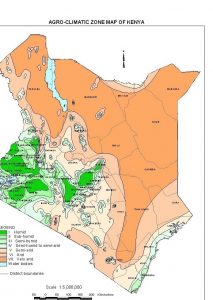
Figure 1: Agro-Ecological Zones of Kenya (Source: Kenya Soil Survey, 1982) shows most of the agriculture is located in the western part of the country.
Livestock keeping under pastoral and ranching establishments are most common in arid and semi arid lands where rainfall amounts are generally low and unevenly distributed to support successful crop production. Thus, pastoralism is the most lucrative production system in such precarious environments unless supplemental irrigation is available.
Although Kenyan agriculture has in many ways all the structural characteristics of modern agriculture in terms of crops, methods and technologies used in production, much of it has co-evolved through time with the history of respective communities. Many crops grown in Kenya as well as the methods used in their production are not indigenous. Still much of Kenyan agriculture is traditional in character, mainly under small scale farming enterprises. Traditional agriculture is characterized by a high degree of biodiversity co-existing in a single plot (Mihindo, 1997). A survey completed by the authors in 2008 of 267 traditional farmers in western Kenya shows that a total of 68 different crops are grown in these small farms (Table 1). Biodiversity has developed through centuries of cultural and biological co- evolution; an outcome of accumulated experiences of local communities interacting with their environment. Although “trial and error” would be expensive with monoculture agriculture, it is least costly when new crops and methods are introduced at micro scales within the high biodiversity of traditional agriculture. Farmers engaged in traditional agriculture mainly utilize self-reliant inventive, experiential knowledge and locally available resources to advance their agricultural practice.
| Table 1: Most frequently mentioned crops grown by 267 traditional farmers surveyed in western Kenya in 2008 by the authors. | Frequency | % |
| Maize | 234 | 87.6 |
| Beans | 191 | 71.5 |
| Sweet potatoes | 123 | 46.1 |
| Millet | 119 | 44.6 |
| Bananas | 112 | 41.9 |
| Cassava | 100 | 37.5 |
| Sorghum | 84 | 31.5 |
| Kale | 63 | 23.6 |
| Pumpkin | 44 | 16.5 |
| Black night shade | 39 | 14.6 |
| Spider weed | 32 | 12.0 |
This paper examines the features of traditional Kenyan agriculture, outlining the ways in which peasant farmers utilize indigenous knowledge to manage their farms and satisfy their subsistence needs while benefiting from the low cost highly diverse cropping relationships and minor economic profits. In Kenya the introduction of modern monoculture from economic development efforts is beginning to compete with and is beginning to reduce the importance of traditional farming. A case is hence made on how traditional agriculture has survived so far and contributed to the preservation of traditional agro ecosystems.
The Context of Traditional Agriculture in Kenya
Traditional agriculture is shaped by the types and distribution of biophysical factors that influence agricultural livelihoods and the indigenous knowledge base of respective communities that guide them. These factors shape the structure that traditional agriculture takes in different environments within Kenya.
The role of biophysical factors
Kenya is a land of great environmental contrasts containing many different climatic, topographical, vegetative and drainage conditions. Local forms of traditional agriculture reflect the differences found in the geographical regions of Kenya. They combine to create seven major agro ecological zones (See Table 2 and Figure 1) based on suitable areas for growing major food and cash crops (FAO, 1996).
Argo-ecological zones are mainly products of a wide range of climatic conditions, which are largely dictated by the highly diverse topographic and moisture generating systems. Topographically, Kenya can be subdivided into highlands and lowlands, a natural setting that determines the classification of crops into lowland and highland crops, and similarly, the types of traditional agriculture practiced. Most of Kenya experiences two rainy seasons including the long rains that normally occur in March through May, and the short rains, which take place in September and October (Figure 2). Wind masses that water the eastern parts of Kenya are generated from the Indian Ocean while those that water the western parts arise from the Congo Basin and Lake Victoria hydro-logical systems.
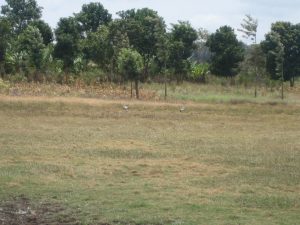
Figure 2: The green of the rainy season contrasts with the brown of the dry season, Kitui County. Photo by Gilbert Nduru 2011,
The highland areas are well watered through orographic processes and are generally endowed with rich fertile soils, which are also well drained and well developed. They receive abundant rainfall (about 11 cm) while experiencing cooler temperatures (about 20 degrees Celsius) as well as relatively low evapo-transpiration. This makes them most suited for crop growing and daily farming. As a result, most of Kenya’s lucrative agriculture is practiced within highland environments. Alternately, most of the lowland areas, including areas in the eastern and northern parts of the country are arid or semi-arid in nature. The rainfall amounts in these areas are generally low (8 cm) and the temperatures (40C) are very high, which results in high rates of evapo-transpiration. Most of these areas however have rich fertile soils, which, if irrigated, can be used for agricultural production.
Table 2: Argo-ecological Zones of Kenya (Source: Kenya Soil Survey, 1982)
| ACZ | I | II | III | IV | V | VI | VII |
| Class | Humid | Sub-humid | Semi- humid | Some what dry | Semi- Arid | Arid | Very
Arid |
| Rainfall in mm | 1100-2700 | 1000-1600 | 800-1400 | 600-1100 | 450-900 | 300-450 | 150-300 |
Indigenous knowledge of local communities
Traditional agricultural practice in Kenya thrives on the basis of a rich system of indigenous knowledge including crafts and technological skills, zoological and botanical knowledge as well as agro-climatological expertise. Usually, farmers, either on their own or cooperatively in conjunction with other members of their neighborhoods, develop their respective knowledge base through time as a product of their interaction with the environments in which they practice their livelihoods. Knowledge and skills are derived through a system of experimentation, spatial cognition and perceptions that lead to the selection of the most adaptive and useful practices. Successful adaptations and practices are preserved and passed on through generations mainly through oral tradition and on-farm practice.
Given the frequent crop and livestock production challenges, including frequent crop failures due to drought, flooding, insect infestations, it has become necessary for scientists to understand traditional agriculture and the knowledge base that it contains. It is evident that traditional farmer’s understanding of their environment, cropping and livestock mobility systems has been enhanced by a complex farming system, which help farmers manage harsh environments to meet their subsistence requirements without reliance on modern agricultural technologies. Understanding these knowledge systems may remedy the deficiencies now being faced in modern agriculture.
Peasant knowledge of environmental factors is detailed and holistic in nature. It includes well established cropping and livestock mobility calendars of events around the year, soil and drainage relationships with productivity, climatic trends and the role of natural vegetation and wild life as indicators of environmental vitality. Their choice of location and production timing was greatly enriched by their mastery of the environment. Moreover, traditional agriculturalists in Kenya also tend to practice many complex systems of crop mixes (Figure 3). They have a carefully developed classification of plants, animals, insects and birds that can or cannot thrive together, a good understanding of the roles of insects and related arthropods as crop pests, causes of disease, as food or as medicinal in their production systems.

Figure 3: A high mix of crops in Nyeri County includes trees, fruits, vegetables, maize, beans, tea, coffee, and grazing land. Photo by Gilbert Nduru.
Their understanding of environmental conditions, fauna and flora has resulted in appropriate farming practices in the face of flooding, droughts, pests and disease, low soil fertility that enhances their coping capacity. Traditional farmers in different parts of Kenya, who are well established have mastered and met the environmental requirements of their food-producing strategies by concentrating on a few principle characteristics and processes resulting in a myriad of agricultural systems. As pointed out by Altieri and Anderson (1986), Kenya’s traditional agricultural practices can be categorized as follows:
a. They combine high species numbers and structural diversity in time and space (both through vertical and horizontal organization of crops). By growing crops together, some crops provide shade or act as supporters to others.
b. They exploit the full range of micro-environments, which differ in soil, water, temperature, altitude and slopes within a field or region (Figure 4).
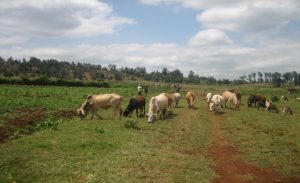
Figure 4: Mixed livestock and cropping is practiced in Nyeri County. Photo b Gilbert Nduru.
These traditional agriculture farming systems maintain closed cycles of materials and wastes through an effective recycling practice both within a farm plot and between several practices within the same plot. The crop-livestock alliance, where livestock graze in empty plots and leave their wastes is also a common practice used to maintain soil fertility while ensuring availability of crop land during the crop growing season (Figure 5).
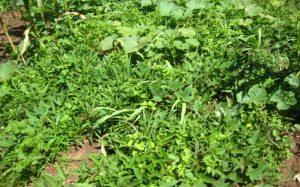
Figure 5: A sweet potato barrier distracts the cattle from invading the maize in Trans-Nzoia County. Photo by Gilbert Nduru.
They generally involve multi-cropping and/or inter-cropping to maximize production and ensure food security (Figures 6 and 7). In so doing they too rely on a complexity of biological inter-dependencies, resulting in some degree of biological pest suppression.
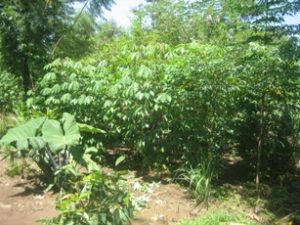

Figures 6 and 7 at variety of crops are grown on the same plot. (cassava, arrow root, sorghum, and pigeon peas) (bananas, maize, coffee pumpkin, and tuber in Saiya County) Photos by Rick Bein
In Nandi North County the crops growing in this plot include sweet potatoes, maize, sugar cane, cassava and pumpkin. In Nyambene County, a mix of arrowroot, beans, maize and potatoes are seen growing together. In both cases, which generally represent the traditional agricultural practices in Kenya, the farmers’ logic in so doing are to ensure that if one crop fails, at least there is another that survives to provide food. Also different crops are plagued by different pests, which mean that if one species is attacked the others might survive. An overriding logic behind the practice is also the fact that crops mature at different times hence ensuring that a farmer has a source of food at every given time. The nutrition mix also ensures that a household has a healthy diet.
They rely on local resources plus human and animal energy, thereby using low levels of input technology (Figure 8).

Figure 8: Fisherman from Lake Victoria adds protein for the diet. Photo by Gilbert Nduru
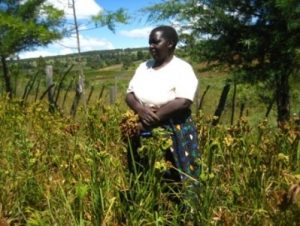
Figure 9: Siaya farmer stands with her mixture of crops. Photo by Rick Bein
Agriculture Products
Traditional agriculture is practiced throughout the country and is composed of crops that are grown mainly for home consumption, although some products are also sold for income whenever there is surplus.
Food production
Generally the traditional crops are high nutrition foods that are eaten at home or traded locally. Many of these crops along with numerous wild plants are also used medicinally. Some of the staple foods of western Kenya include sorghum, finger millet (Figure 10), arrowroot, beans, black night shade, sweet potatoes, kale, and cow peas. Maize cake (ugali) is a major component of the diet. Many greens, some of which grow semi-wild, are consumed as vegetables. What might be considered a weed in some communities is often eaten as a salad by others. A good example is the black bight shade, which is considered a delicacy in the western region while in the eastern parts of Kenya it is a weed (Table 3).
Table 3: Frequency of weeds used by 267 traditional farmers in western Kenya surveyed by the authors in 2008
| Number | % | |
| Use weeds | 258 | 96.6 |
| Do not use weeds | 9 | 3.4 |
| Total | 267 | 100 |
Medicinal crops
Traditional farmers also grow some crops that not only provide food but are also of medicinal value (Table 4). Examples are the black night shade, products of the neim tree, Sodom apples and the fat of sheep, goats, chickens, and pigs. One product called “black jack” is highly prized for its blood clotting capacity. Every house hold lists several unique medical plants. See figure 11.
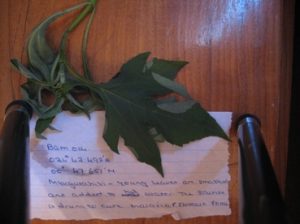
 Figure 11: Medicinal plants are included in the crop mix in Uasin Gishu County. Leaf photo 1 is used for malaria. Photos by Rick Bein
Figure 11: Medicinal plants are included in the crop mix in Uasin Gishu County. Leaf photo 1 is used for malaria. Photos by Rick Bein
Table 4: Frequency of farm products being used as medicine by 267 traditional farmers in western Kenya surveyed by the authors in 2008
| Options | Frequency | % |
| Some farm products used as medicine | 244 | 91 |
| No farm products used as medicine | 17 | 6.4 |
| No response | 6 | 2.2 |
| Total | 267 | 100 |
Commercial products
Although the main focus of traditional agriculture in Kenya is generally aimed at ensuring food security at household levels, but recently, there has been a rapid increase in trade involving products from traditional farming systems (Tables 5) (Figure 12).
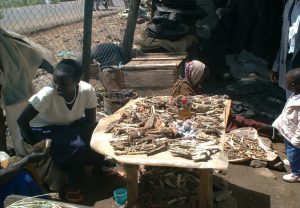
Figure 12: A trader displays some plant products for sale as herbal medicine in Kabarnet, Elgeyo Marakwet County. Photo by Gilbert Nduru.
Table 5: Frequency of 267 traditional farmers in western Kenya selling any products surveyed by the authors in 2008
| Options | Frequency | % |
| Sell some farm produce | 172 | 64.4 |
| Sell no farm produce | 91 | 34.1 |
| No response | 4 | 1.5 |
| Total | 267 | 100 |
The Challenge of monoculture
Commercial agriculture has been present in several forms that include plantation crops such as tea and coffee mostly for export; cane sugar intended for export but recently falls short of meeting domestic consumption; green house flowers for export; specialized organic vegetable farming for European markets; and maize and wheat for domestic consumption. All of these, except some of the peasant grown maize reaches the domestic market in years of surplus, are driven by big capital investment. Except for the peasant grown maize and the organic vegetables, this farming is heavily invested in inputs of large machinery, chemical fertilizers, herbicides and pesticides. Less than 10 % of Kenyans are employed in this type of agriculture in contrast to more than 70% who engage in traditional agriculture.
Yet this commercial agriculture is not sustainable in its present form. The fossil fuel base is finite and the pollution that it produces is devastating to the environmental health of the planet.
The commercial agriculture is heavily subsidized by foreign aid, government programs and private entrepreneurs. These monocultures are highly promoted by government extension, agricultural schools and private agricultural support industries like seed producers, and chemical and veterinary supply companies. This infrastructural support is phenomenal when compared to any infrastructure afforded the traditional farmers. At best the infrastructure available to the traditional farmers would be the poorly maintained dirt roads and an occasional extension service officer promoting monoculture practices.
We are of the opinion that traditional agriculture offers resources that are largely ignored in Kenya. First, seventy percent of Kenyans are engaged in traditional agriculture and including them in the economy, would pay high social benefit to the nation.
Secondly, if supported with a small amount of infrastructure, a proportionally higher dividend would be realized by Kenyans as a whole. Infrastructure such as improved roads, and community based canning industries to capture the small surpluses that normally rot in the fields would provide a steady and perhaps significant amount of food stuff to Kenya markets.
Another very valuable, but low cost input would be to develop local information gathering groups (possibly recent high school graduates) who would record the traditional agricultural practices and strategies and make the information available throughout their communities and beyond. This would provide integrity to tradition agriculture systems and allow the farmers to become part of the larger economy. The knowledge of traditional agriculture would not be lost but would be become a benefit that would be shared. And with this accumulation of local information the level of formal education of these peasant communities would also rise.
However, here is little glamour in investing in subsistence agriculture where it appears that it would only slightly reduce poverty. Investment in what is already successful seems safe. Large funding goes to what the West has described as how agriculture should look. There is much more political payback from those large investment development projects.
Conclusion
The advantages of traditional agriculture are multiple. Different crops mature at different times, ensuring food security during the year. Intercropping/polyculture farming practice reduces labor costs with regard to weeding and pest control while the different crops support each other with fertilization, shade and pest repellents. Wild products are available at different times of the year in the form of plants, roots, legumes and tubers. Some crop products and plants are medicinal. Most of the traditional crops are more suited to harsh climatic conditions currently prevalent over most parts of Kenya than are some modern crops. And furthermore, traditional farmers can sell some of their products for income.
More study is required on the role of traditional food crops in ensuring sustainable food production and supply in Kenya and other parts of Africa. More research is necessary on the role of traditional crops as sources of income. There is need for more research on the nutritional value of respective crops. There is a need for a framework for developing infrastructure for traditional farming that should involve those farmers in policy development and marketing. The Kenyan government should stop ignoring traditional agriculture and find ways to support it.
References
Altieri, M.A. and M.K. Anderson (1986). An ecological basis for the development of alternative
agricultural systems for small farmers in the Third World. American Journal of Alternative Agriculture 1:30-38.
FAO Land and Management Division (1996). FAO Bulletin 73; Soil resources, Management and
Conservation Service. FAO, Rome.
Mihindo, N. (1997). Organic agriculture in Kenya: fusion of science and traditional knowledge. In
Guarino, L. (Ed) Traditional African Vegetable: Promoting the Conservation and Use of Underutilized and Neglected crops. 16, IPGRI, Rome.
Nduru, G.M. (2011). Resource Use Conflicts and Soil Conservation Efforts. International Book Market Service, 17 Meldrum St. Beau-Basim, Mauritius.
Population Reference Bureau (2011) World Population data Sheet, pp 10. PRB. Washington DC.

